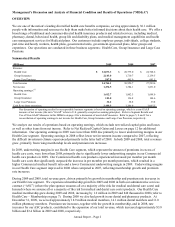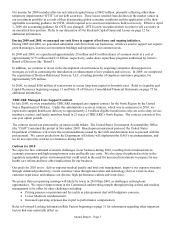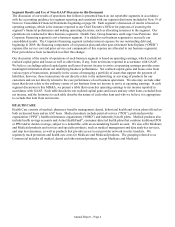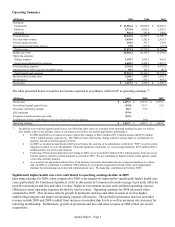Aetna 2009 Annual Report Download - page 18
Download and view the complete annual report
Please find page 18 of the 2009 Aetna annual report below. You can navigate through the pages in the report by either clicking on the pages listed below, or by using the keyword search tool below to find specific information within the annual report.Annual Report – Page 12
We classify our debt and equity securities as available for sale, carrying them at fair value on our balance sheet.
Approximately 3% of our debt and equity securities at both December 31, 2009 and 2008 are valued using inputs that
reflect our own assumptions (categorized as Level 3 inputs in accordance with GAAP). Refer to Note 10 of Notes to
Consolidated Financial Statements beginning on page 63 for additional information on the methodologies and key
assumptions we use to determine the fair value of investments.
At December 31, 2009 and 2008, our debt and equity securities had net unrealized gains (losses) of $717 million and
$(500) million, respectively, of which $207 million and $(123) million, respectively, related to our experience-rated
and discontinued products.
Refer to Note 8 of Notes to Consolidated Financial Statements beginning on page 58 for details of net unrealized
capital gains and losses by major security type, as well as details on our debt securities with unrealized losses at
December 31, 2009 and 2008. We regularly review our debt securities to determine if a decline in fair value below the
carrying value is other than temporary. If we determine a decline in fair value is other than temporary, the carrying
value of the security is written down. The amount of the credit-related impairment is included in our results of
operations, and the non-credit component is included in other comprehensive income if we do not intend to sell the
security. Accounting for OTTI of our debt securities is considered a critical accounting estimate. Refer to Critical
Accounting Estimates - Other-Than-Temporary Impairment of Debt Securities on page 21 for additional information.
Net Realized Capital Gains and Losses
Net realized capital gains (losses) were $55 million in 2009, $(656) million in 2008 and $(74) million in 2007.
Included in these amounts were $76 million for 2009, $523 million for 2008 and $125 million for 2007 of yield-related
OTTI losses.
The decrease in OTTI recognized in earnings in 2009 compared to 2008 was primarily related to a change in the
accounting guidance for the recognition of OTTI of debt securities and an overall general improvement in the
economic environment during 2009 compared to 2008. Prior to the adoption of new accounting guidance for OTTI of
debt securities on April 1, 2009, both yield- and credit-related OTTI were recognized in earnings if we could not assert
our intention to hold the security until recovery. In contrast, after April 1, 2009, only credit-related impairments are
recognized in earnings unless we have the intention to sell the security in an unrealized loss position, in which case the
yield-related OTTI is also recognized in earnings. Refer to Note 2 of Notes to Consolidated Financial Statements
beginning on page 48 for additional information.
In 2009, yield-related OTTI losses were $76 million, primarily related to U.S. Treasury and corporate securities that
were temporarily in a loss position due to changes in interest rates and the widening of credit spreads relative to the
interest rates on U.S. Treasury Securities in the first half of 2009. Because we did not assert our intention to hold these
securities, under applicable accounting guidance, we recorded a yield-related OTTI loss. In 2008, yield-related OTTI
losses were $523 million. These yield-related impairments were primarily due to the widening of credit spreads
relative to the interest rates on U.S. Treasury securities in 2008 and the application of the then-applicable accounting
guidance for OTTI which required us to assert our intention to hold to recovery, which we could not make. During
2008, significant declines in the U.S. housing market resulted in the credit and other capital markets experiencing
volatility and limitations on the ability of companies to issue debt or equity securities. The lack of available credit,
lack of confidence in the financial sector, increased volatility in the financial markets and reduced business activity
resulted in credit spreads widening during 2008.
Included in net realized capital losses for 2008 were $120 million of credit-related OTTI losses of which $105 million
related to investments in debt securities of Lehman Brothers Holdings Inc. and Washington Mutual, Inc. We had no
other individually material realized capital losses on debt or equity securities that impacted our results of operations
during 2009 or 2008.
Mortgage Loans
Our mortgage loan portfolio (which is collateralized by commercial real estate) represented 8% and 10% of our total
invested assets at December 31, 2009 and 2008, respectively. At December 31, 2009, 99% of our mortgage loans
continued to be performing assets. In accordance with our accounting policies, there were no material impairment
reserves on these loans at December 31, 2009 or 2008. Refer to Notes 2 and 8 of Notes to Consolidated Financial
Statements beginning on pages 48 and 58, respectively, for additional information.
























